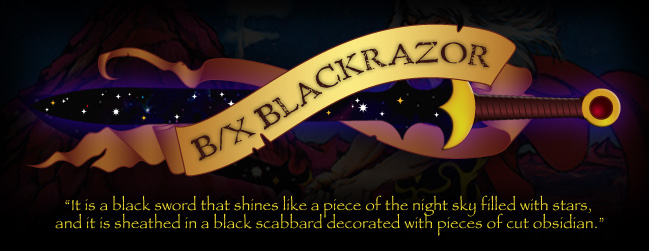Arena AEmilia (Zed)
B/X for PCs of 4th-6th level
Mm. I was wondering if I'd see one of these.
For my review criteria, you may check out this post. All reviews will (probably) contain *SPOILERS*; you have been warned! Because these are short (three page) adventures, it is my intention to keep the reviews short.
Well, now. It seems I must explain what an "adventure" is.
Strictly speaking, adventuring is the activity that players engage in when they play D&D; Moldvay's (B/X) glossary defines an adventure as "any session where a DM and players meet to play a D&D game." However, the textual description is a bit more specific:
Each game session is called an adventure. An adventure lasts for as long as the players and the DM agree to play. An adventure begins when the party enters a dungeon, and ends when the party has left the dungeon and divided up treasure. An adventure may run for only an hour, or it might fill an entire weekend! The amount of playing time depends on the desires of the players and the DM. Several related adventures (one adventure leading to another, often with the same player characters) is called a campaign.
In the (later) Expert set, the scope of where an adventure takes place is broadened to include the wilderness, defined as all the area outside of the dungeon. And yet, the dungeon is ever the focus of the Dungeons & Dragons game.
A "dungeon" is defined by Moldvay as "a place, underground and often among ruins, where characters adventure." Again the textual description is more broad than that:
It is the DM's job to prepare the setting for each adventure before the game begins. This setting is called a dungeon since most adventures take place in underground caverns or stone rooms beneath old ruins or castles.
Note that Moldvay states MOST adventures take place underground...not all. In the Dungeon Master Information section of the Basic D&D rules, Moldvay provides a "step-by-step guide to creating a dungeon." The second step, DECIDE ON A SETTING, makes clear that not all settings need be underground, as his list of "common settings" include castles, towers, ancient temples, strongholds, and towns. Not every "dungeon" need be a ruin, cavern, or tomb.
However, the setting (where the adventure takes place) is, as stated, the second ("B.") step of creating a dungeon, i.e. creating the place where adventuring will take place during the game. The FIRST ("A.") step is the choosing of a scenario:
A. CHOOSE A SCENARIO
A scenario is a background theme or idea which ties the dungeon together. A scenario will help keep a dungeon from becoming a boring repetition of "open the door, kill the monster, take the treasure." A good scenario always gives the players a reason for adventuring. The DM should also design a dungeon for the levels of characters who will be playing in it. A good scenario will also give the DM a reason for choosing specific monsters and treasures to put in the dungeon.
This, I would argue, is the HEART of adventure design. Without a scenario, there is little reason to adventure...D&D simply becomes a game of rolling dice until resources are expended or boredom overtakes us. The scenario provides context for adventuring; it helps focus the players and promotes active engagement with the setting (i.e. "the dungeon") where the adventuring is taking place. Readers might note that this paragraph on scenario choice provides at least part (if not most) of my judging criteria.
SO...let's look at this Arena AEmilia. It provides a setting...a place. The place is stocked mostly with NPC characters, though there are a few beasties in animal pens. The NPCs are given some personality notes. The setting has a map. There is treasure listed...in exceptionally poor amounts for adventurers of levels 4th-6th.
But there is no scenario presented.
There is no reason for PCs to go here. There is no adventure. There is an arena. There are people. There are shiny silver coins in their purses. I suppose you can kick open doors and stab people for their purses of silver coins, but I'd like to think we've long since evolved past that type of play. This is D&D, not Greg Costikyan's Violence RPG.
This is not an adventure. It receives the coveted zero stars (out of five) award.

Blackrazor stars are a strictly limited resource. After the 5-star opulence, we are bound to see a lot of 0- or 1-star reviews. ;D
ReplyDeleteThere may be a couple more low-rated reviews in the mix, but (*spoiler*) this is the only zero star review you'll see...in this exercise anyway.
Delete